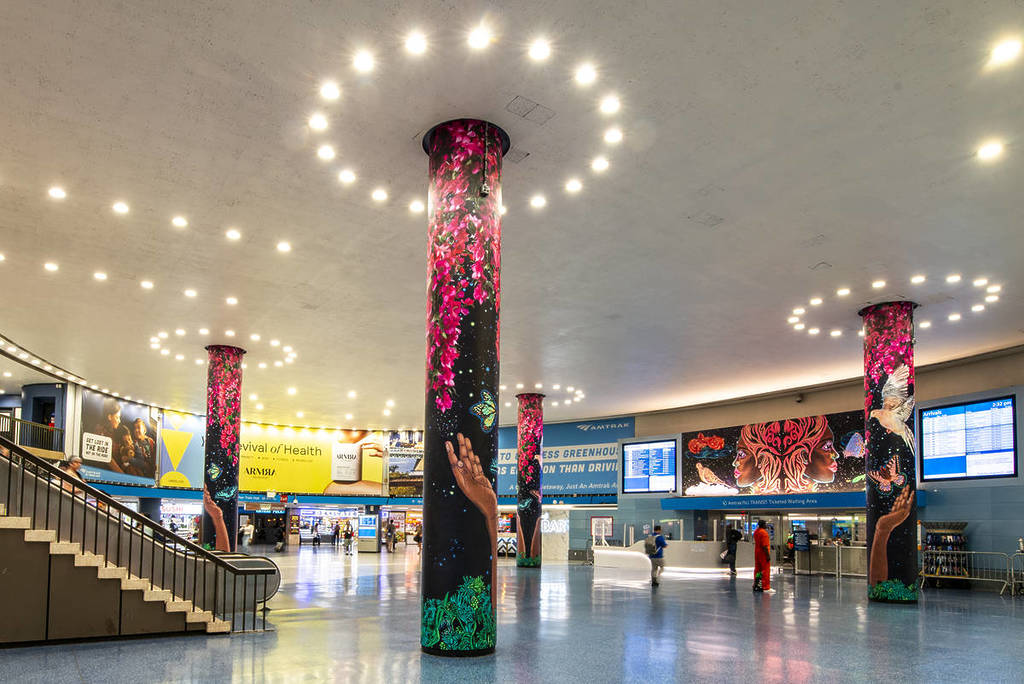New York City’s Penn Station, long known for its utilitarian purpose and bustling crowds, has recently undergone a striking transformation, thanks to the vibrant and captivating art installations now gracing its halls. As part of the ongoing *Art at Amtrak* initiative, two large-scale works by local artists Chitra Ganesh and Eirini Linardaki have been unveiled, bringing a much-needed touch of creativity and beauty to the transit hub. These installations are not just decorative elements but powerful expressions of storytelling, identity, and imagination, reflecting both the pulse of the city and the lives of those who pass through it daily.
The “Art at Amtrak” Initiative: Reimagining Penn Station
The Art at Amtrak initiative is a significant effort by Amtrak to enhance the travel experience by bringing public art to Penn Station. As one of the busiest transportation hubs in the world, the station serves as a gateway to New York City for millions of travelers. However, Penn Station’s history is also one of controversy and transformation. Once a grand Beaux-Arts masterpiece, the original structure was demolished in the 1960s to make way for a more functional (yet aesthetically lacking) design. Over the years, it became clear that Penn Station needed more than just a facelift—it needed a reimagining that would bring a sense of culture and community to the space.
Enter the “Art at Amtrak” initiative. Through this program, Amtrak seeks to showcase the work of local artists while turning Penn Station into a place where creativity can flourish. The idea is to create a more enriching, humane experience for commuters and travelers, allowing them to engage with the art as they move through the station. By incorporating art into the fabric of Penn Station, Amtrak is reasserting the idea that public spaces can serve a higher purpose beyond their functionality.
Chitra Ganesh: A World of Myths and Fantasy
One of the standout works in this latest wave of installations comes from Brooklyn-based artist Chitra Ganesh. Known for her vivid and fantastical art that blends South Asian iconography with Western comic styles, Ganesh’s work often explores themes of identity, gender, myth, and history. Her practice is deeply rooted in storytelling, and her piece for Penn Station is no exception.
Ganesh’s installation, titled “The City Beneath Our Feet”, immediately grabs attention with its bold colors and surreal visuals. The work is a large-scale mural that sprawls across one of the station’s main corridors, a dynamic composition that draws on both mythological and futuristic imagery. Figures in the piece seem to move through different dimensions, existing in a dreamlike space that feels at once ancient and cutting-edge.
Ganesh has long been interested in exploring stories that are marginalized or forgotten, particularly those centered on women and non-Western cultures. In “The City Beneath Our Feet”, she brings these themes to the forefront, creating a world that celebrates diversity, fantasy, and transformation. For commuters passing through Penn Station, the mural offers a moment of reflection—an opportunity to step into another world, even if only for a few seconds. The surreal, multi-layered narrative encourages travelers to imagine what lies beneath the surface of everyday life, inviting them to think about their own journeys in new and expansive ways.
Ganesh’s work is a reminder that art in public spaces can serve as a mirror to the complexities of contemporary life, offering both escape and insight. In a bustling, often chaotic environment like Penn Station, her mural provides a moment of beauty, wonder, and contemplation.
Eirini Linardaki: A Celebration of Connectivity
Equally impactful is the work of Greek-French artist Eirini Linardaki, whose large-scale installation also plays a central role in reimagining Penn Station’s interior. Linardaki’s work, “Journeys in Color”, is a celebration of human connection and movement, themes that resonate deeply in a place like Penn Station, where thousands of people cross paths every day.
Linardaki’s piece consists of vibrant, abstract shapes that span across the ceiling and walls of one of the station’s busiest concourses. The shapes and colors appear to dance and flow, evoking a sense of energy and motion. This dynamic quality reflects the constant movement of people within the station, creating a visual rhythm that echoes the patterns of daily life in the city.
What makes Linardaki’s work particularly striking is her use of color to create an emotional experience. The bold, bright hues of the installation inject a sense of joy and vitality into the space, transforming the often-dreary atmosphere of Penn Station into something far more uplifting. The installation seems to celebrate the idea of travel as an act of connection, both physically and emotionally. The shapes within the work evoke maps and networks, alluding to the idea of travel not just as a means of getting from point A to point B, but as a way of connecting people, ideas, and cultures.
Linardaki’s background in both fine art and public projects shines through in this installation. She has a keen understanding of how art can interact with its surroundings, and in the case of “Journeys in Color”, she uses the station’s architecture as a canvas, creating a harmonious relationship between the built environment and her abstract forms. For travelers, the installation offers a moment of pause—a chance to look up, take in the colors, and feel a sense of connection to the people around them.
The Impression of Art in Public Spaces
The addition of Chitra Ganesh and Eirini Linardaki’s installations to Penn Station is a significant moment for both the station and the city. Public art has long been a way to engage communities, inspire reflection, and foster a sense of belonging in urban spaces. In a place like Penn Station, where the focus is often on the rush to get from one place to another, the presence of these works serves as a reminder of the importance of slowing down and taking in one’s surroundings.
Art in public spaces like Penn Station also plays a critical role in democratizing access to culture. Not everyone has the opportunity to visit galleries or museums, but in a place like Penn Station, art becomes part of the everyday experience. By bringing works from local artists into this highly visible space, the “Art at Amtrak” initiative makes culture accessible to a broad audience, enriching the lives of people who might not otherwise engage with contemporary art.
Furthermore, these installations are not just decorative; they have the power to transform the way people experience Penn Station. The combination of Ganesh’s mythological storytelling and Linardaki’s celebration of human connectivity turns the station into a place of imagination, reflection, and joy. In a city that is always moving, these artworks remind us to pause, look around, and appreciate the creativity that surrounds us.
A New Chapter for Penn Station
The latest installations by Chitra Ganesh and Eirini Linardaki mark a new chapter in the ongoing transformation of Penn Station. Through their vibrant, imaginative works, these artists have succeeded in turning a once purely functional space into a place where art, culture, and community come together. “Art at Amtrak” is more than just an initiative to beautify the station; it’s a testament to the power of public art to inspire, connect, and transform urban spaces.
As travelers pass through Penn Station, they are now greeted with a sense of wonder and possibility, thanks to the bold visions of these two artists. Whether it’s the fantastical world of Ganesh’s mural or the energetic flow of Linardaki’s abstract forms, these installations invite us all to see the city—and ourselves—in a new light.
No comments yet.








